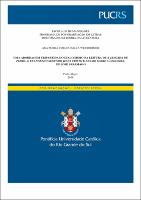| Share record |


|
Please use this identifier to cite or link to this item:
https://tede2.pucrs.br/tede2/handle/tede/8362| Document type: | Tese |
| Title: | Uma abordagem tripartida do dialogismo na leitura de A jangada de pedra, O Evangelho segundo Jesus Cristo e Ensaio sobre a cegueira, de José Saramago |
| Author: | Wertheimer, Ana Maria Coelho Silva  |
| Advisor: | Kohlrausch, Regina |
| Abstract (native): | Esta tese propõe uma abordagem tripartida do dialogismo para a análise de três romances de José Saramago (1922–2010), quais sejam, A jangada de pedra, O Evangelho segundo Jesus Cristo e Ensaio sobre a cegueira, selecionados por tratarem, respectivamente, temas de cunho político, religioso e social. À luz das teorias de Mikhail Bakhtin (1895–1975), cuja produção intelectual se prolongou por cerca de sessenta anos – o que pode justificar o uso do termo diálogo em contextos e com conceitos distintos –, este estudo é orientado por três possíveis acepções dentro da teoria do dialogismo: o diálogo na teoria da linguagem, o diálogo no romance e o diálogo na memória dos gêneros. Sem fazer tábula rasa da vasta fortuna crítica do escritor português, esta tese pretende responder a uma questão: como as relações dialógicas se constituem nos romances de Saramago? Na busca por uma resposta, surge uma segunda questão, mais complexa, – É possível que as relações dialógicas na tessitura do discurso das personagens e do narrador saramaguiano representem uma teoria do processo de criação literária? A hipótese norteadora é a de que a forma artística do escritor, precisamente a prosa polifônica, constitua, para além de uma tendência, uma renovação própria do gênero. Este trabalho, portanto, está organizado em três partes: a primeira dedica-se ao diálogo no nível da linguagem, no que tange ao sentido ideológico do signo linguístico e aos diferentes tipos de discurso citado; a segunda parte aborda o diálogo no romance, o que corresponde à heteroglóssia e à polifonia no discurso romanesco; e a terceira parte, na esfera da memória dos gêneros, investiga aspectos da literatura carnavalesca e das estruturas cronotópicas que constituem as narrativas. Acrescenta-se à leitura das teorias bakhtinianas, considerações de pesquisadores como, Michael Holquist, Gary Saul Morson, Caryl Emerson e, do Brasil, Irene Machado, Beth Brait, Carlos Alberto Faraco, Cristovão Tezza, entre outros que buscam compreender e sistematizar as concepções do teórico russo. Estima-se que um trabalho que atente para a análise da escrita de Saramago possa contribuir tanto para um estudo de seu processo criativo quanto para uma (re)leitura do princípio dialógico de Bakhtin nos domínios da Teoria da Literatura. |
| Abstract (english): | This thesis proposes a tripartite approach to dialogism for the analysis of three novels by José Saramago (1922-2010), namely, A jangada de pedra, O Evangelho segundo Jesus Cristo and Ensaio sobre a cegueira, which were selected by the reason that they approach political, religious and social issues, respectively. Based on the theories of Mikhail Bakhtin (1895-1975), whose intellectual production lasted for about sixty years – which may justify the use of the term dialogue in different contexts and with distinct concepts –, this study is guided by three possible meanings within dialogism: the dialogue in the theory of language, the dialogue in the novel and the dialogue in the genre memory. Without ignoring the vast critical reviews of the Portuguese writer’s work, this thesis intends to answer a question: how are dialogic relationships established in Saramago's novels? Searching for an answer, a second, more complex question arises: is it possible that the dialogic relationships in the narrative structure of Saramago’s characters and narrator represent his process of literary creation? The hypothesis is that the artistic form of the writer represents, besides a tendency, a renewal of the genre itself. This study is, therefore, divided into three parts: the first is dedicated to the dialogue at the level of language, regarding the ideological sense of the linguistic sign and the different types of the reported speech; the second part approaches the dialogue in the novel, focusing on the plurilingual and polyphonic features of the discourse in the novel; and the third part, in the sphere of the memory of the genre, investigates aspects of carnival literature and chronotopic structures that constitute the narratives. It is added to this study the ideas of researchers such as Michael Holquist, Gary Saul Morson, Caryl Emerson and, from Brazil, Irene Machado, Beth Brait, Carlos Alberto Faraco, and Cristovão Tezza, among others who seek to understand and systematize Bakhtin’s concepts. It is expected that a study that examines Saramago's writing can contribute both to a reflection on his creative process and also to a (re)reading of Bakhtin's dialogic principle in Literature. |
| Keywords: | José Saramago Mikhail Bakhtin Dialogismo Polifonia Cronotopo |
| CNPQ Knowledge Areas: | LINGUISTICA, LETRAS E ARTES::LETRAS |
| Language: | por |
| Country: | Brasil |
| Publisher: | Pontifícia Universidade Católica do Rio Grande do Sul |
| Institution Acronym: | PUCRS |
| Department: | Escola de Humanidades |
| Program: | Programa de Pós-Graduação em Letras |
| Access type: | Acesso Aberto |
| Fulltext access restriction: | Trabalho não apresenta restrição para publicação |
| URI: | http://tede2.pucrs.br/tede2/handle/tede/8362 |
| Issue Date: | 28-Sep-2018 |
| Appears in Collections: | Programa de Pós-Graduação em Letras |
Files in This Item:
| File | Description | Size | Format | |
|---|---|---|---|---|
| Wertheimer Ana Maria TESE.pdf | ANA_MARIA_COELHO_SILVA_WERTHEIMER_TES | 2.05 MB | Adobe PDF |  Download/Open Preview |
Items in DSpace are protected by copyright, with all rights reserved, unless otherwise indicated.




